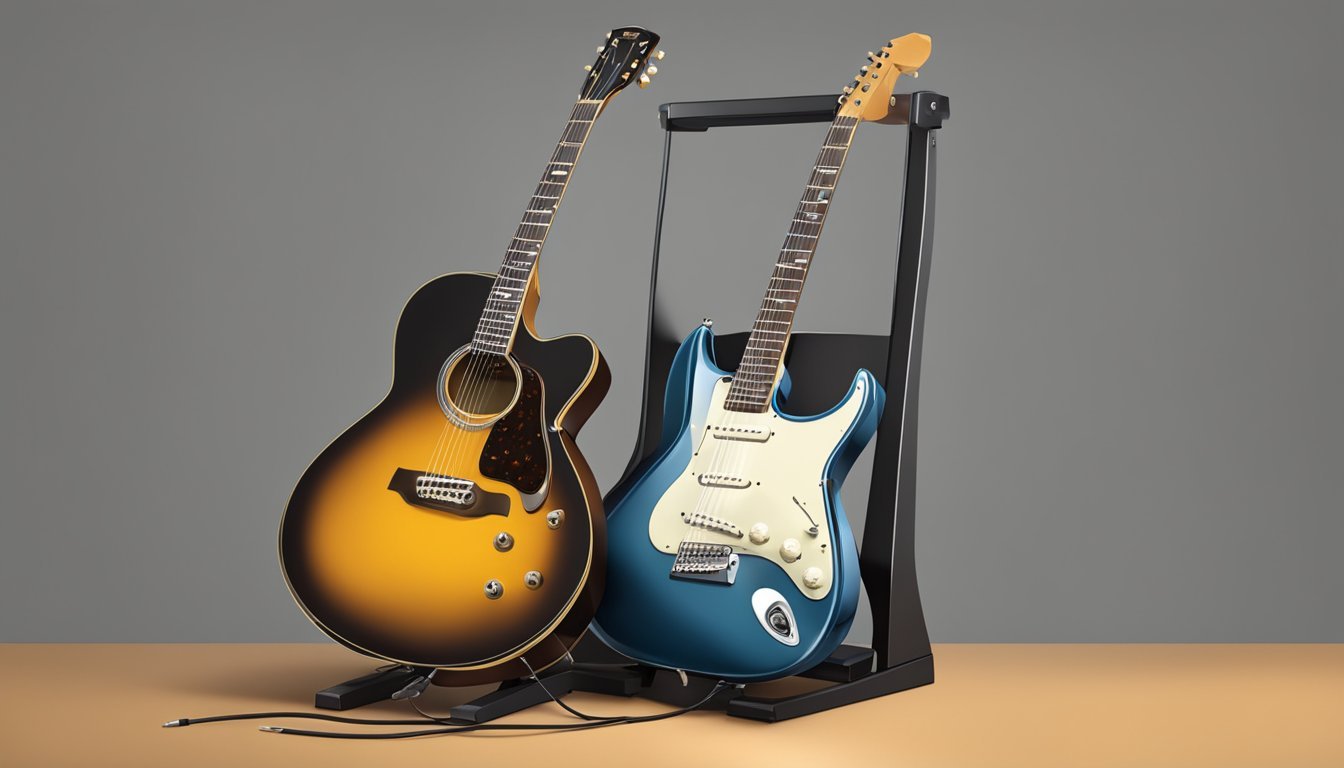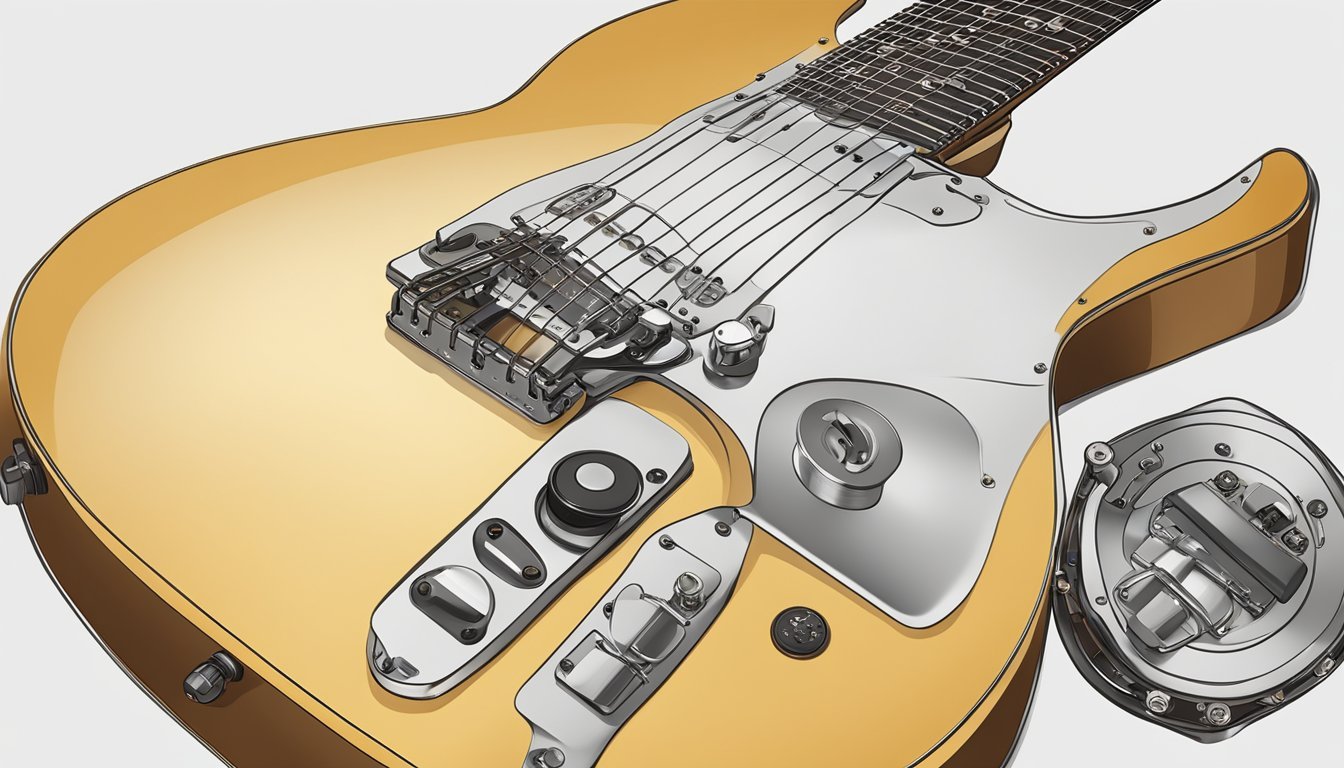When you pick up an electric guitar, you might not think about the pickup.
A guitar pickup is a device that captures the vibrations of the strings and converts them into an electrical signal, which then produces sound through an amplifier.
Understanding how pickups work can help you choose the right sound for your style and music preference.

There are various types of pickups, each with its own design and sound characteristics.
Whether you lean towards the bright tones of single-coil pickups or the rich warmth of humbuckers, knowing what each type offers will guide your decision.
As you explore different genres, you’ll find that pickups play a key role in shaping your overall sound.
Key Takeaways
- Pickups convert string vibrations into electrical signals for amplification.
- Different types of pickups create distinct sound qualities.
- Choosing the right pickup enhances your music across various genres.
Understanding Guitar Pickups
Guitar pickups are essential for electric guitars.
They capture the vibrations of your strings and transform them into sound.
In this section, you will learn about the different pickup types, how they work, and the differences between active and passive pickups.
The Role of Pickups in Electric Guitars
Pickups are like the ears of your electric guitar.
They detect the vibrations from the strings when you play.
This detection happens through magnetic fields created by the pickups.
The most common type is the magnetic pickup.
When you pluck a string, it vibrates within the magnetic field.
This action generates an electrical signal.
That signal travels through the guitar’s wiring to the amplifier, where it turns into sound.
Your choice of pickup can greatly influence your guitar’s tone, making it brighter or warmer.
Different Pickup Types Explained
There are several types of guitar pickups, each offering unique sounds.
Here are the main ones:
-
Single-Coil Pickups: Known for their bright and clear tone, these are common in genres like rock and country. They can pick up unwanted noise, which can be a downside.
-
Humbuckers: These pickups consist of two coils. They cancel out the hum and produce a thicker sound. If you play jazz or heavier rock, humbuckers are popular for their warm, full tones.
-
P90 Pickups: A middle ground between single-coils and humbuckers. P90s provide a punchy tone with some rawness, making them suitable for various styles.
-
Acoustic Guitar Pickups: These pickups are designed for acoustic guitars. They can be magnetic, but more often use piezo pickups that sense the vibrations differently.
Knowing about these different types helps you pick the right one for your playing style and sound preferences.
Active vs. Passive Pickups
Pickups fall into two main categories: active and passive.
Active pickups require a battery or external power source.
They provide a stronger signal and reduce noise, often giving a more powerful sound.
Musicians often prefer them for genres like metal and hard rock.
Passive pickups, on the other hand, do not need a battery.
They are simpler and tend to have a classic, vintage tone.
Many guitarists love these for their warmth and dynamics.
Your choice between active and passive pickups will depend on your music style and the sound you want to achieve.
Pickup Design and Materials
When it comes to guitar pickups, design and materials play a crucial role in how your instrument sounds.
The right combination influences tone and performance, making it essential to understand what goes into them.
Pole Pieces and Magnetic Fields
Pole pieces are critical components of pickups.
These are the metal parts that sit beneath the strings and help capture vibration.
They help create a magnetic field that interacts with the strings.
In single-coil pickups, the pole pieces are usually made of iron or steel.
This design gives a bright and clear sound.
On the other hand, humbucker pickups use two coils and can have adjustable pole pieces.
This setup helps reduce unwanted noise and gives a thicker tone.
The strength of the magnetic field can vary too.
A stronger field can enhance output and sustain but may also lead to a more pronounced tone.
Finding the right balance is key.
Selecting the Right Pickup Material
Different materials affect how pickups react to sound.
Alnico magnets, made from aluminum, nickel, and cobalt, are popular.
They deliver a warm tone and good response, which musicians really like.
Ceramic magnets are another choice.
They tend to be stronger and provide a brighter sound.
Many guitarists prefer them for rock or metal styles due to their higher output.
You should also consider the wire used in pickups.
The gauge, material, and insulation can change tone and clarity.
Thinner wires give a brighter sound, while thicker wires may add warmth.
By carefully selecting materials, you can customize how your guitar sounds to fit your style.
Guitar Pickups and Sound Characteristics
Guitar pickups play a crucial role in shaping your sound.
Their type, position, and design can greatly affect tone, clarity, and interference levels when playing.
Let’s dig into how these factors influence what you hear.
How Pickups Influence Guitar Tone
Pickups can be broadly categorized into two types: single-coil and humbuckers.
Single-coil pickups are known for their bright, clear sound but can be susceptible to 60-cycle hum and electromagnetic interference.
This is especially true in high-gain situations, which can muddy your tone.
On the other hand, humbuckers use two coils that work together to cancel out the noise.
This gives them a thicker, warmer sound, making them popular for jazz and rock genres.
Choosing the right pickup type is essential for controlling your guitar tone.
Understanding Pickup Position and Sound Variability
The position of your pickups also matters.
The neck pickup usually produces a warmer, bass-heavy tone, perfect for blues and jazz.
In contrast, the bridge pickup offers a sharper, more cutting sound that works well for rock and metal.
Experimenting with pickup position can yield different tonal qualities.
For example, using both pickups together can create a unique blend, giving you versatility in your sound.
You should try different combinations to find the one that suits your style best.
Dealing with Hum and Interference
When using single-coil pickups, you might notice unwanted noise.
This is called 60-cycle hum.
You can manage this issue by positioning your guitar away from potential interference sources like lights and amplifiers.
Another option is to consider noiseless single-coil pickups.
These pickups aim to give you the classic single-coil sound without the noise.
They are designed to reduce interference, giving you cleaner sound quality.
You can keep enjoying that bright tone without the hassle of hum.
Pickups Across Music Genres
Different music genres have unique sounds and styles.
The type of guitar pickup you choose can enhance the characteristics of these genres.
Let’s explore how pickups play a key role in jazz, rock, and blues.
Pickups in Jazz: Warmth and Clarity
In jazz music, you typically want a warm and clear tone. Humbucker pickups are a popular choice here.
They provide a smooth, rounded sound that complements the intricate melodies of jazz.
Jazz guitarists often use models like the Gibson ES-335.
With its rich tones, this guitar helps musicians express their creativity.
You can also find single-coil pickups in certain jazz guitars, which add a bright edge to solos.
The clarity is crucial for playing clean lines.
This allows every note to shine through, even in fast-paced solos.
If you’re aiming for that classic jazz sound, consider these pickup choices.
Rock and Metal: Power and Precision
When it comes to
rock and metal
, you need pickups that deliver power and precision. Humbucker pickups take the lead in this genre as well.They handle high gain without losing clarity, making them perfect for heavy riffs and solos.
In hard rock, a guitar like the Gibson Les Paul often shines with its humbucker pickups.
These pickups give a thick, full-bodied tone ideal for distortion.
They work great for genres like punk rock and rockabilly too, amplifying energy and grit.
For metal tones, switch to higher-output pickups.
This will provide sharper attacks and sustain for those intricate solos.
Think about brands like EMG or Seymour Duncan for specific metal-focused pickups.
Blues and Clean Tones: Expression and Dynamics
Blues music relies heavily on expression and dynamics.
Single-coil pickups are often favored for their bright and sharp sound.
They allow you to capture the subtle nuances in your playing.
You’ll often see guitars like the Fender Stratocaster being used for blues.
This model has single-coil pickups that bring out those clean tones.
Great for both rhythm and lead, they respond well to your touch.
Additionally, the combination of humbuckers and single coils can create a versatile setup.
This way, you can switch between a smooth, warm sound and bright, cutting tones.
It’s all about finding the right balance for your blues vibe.
Frequently Asked Questions

Let’s tackle some common questions about guitar pickups.
These include how they work, the differences between types, and what you should know when choosing them.
How do guitar pickups actually work?
Guitar pickups work by detecting the vibrations of the strings.
They consist of magnets and coils of wire.
When you pluck a string, it vibrates and this movement creates an electrical signal.
That signal is then sent to the amplifier.
The strength and clarity of the signal depend on the type of guitar pickup used, whether it’s single-coil or humbucker.
Different pickups can significantly affect the tone and character of the sound produced, allowing musicians to explore a wide range of auditory textures.
Thus, the guitar pickup function explained offers valuable insight into how these components shape the overall sound of an electric guitar.
What’s the difference between single-coil and humbucker pickups?
Single-coil pickups capture a brighter, sharper tone.
They are great for clean sounds, but can pick up interference.
Humbuckers, on the other hand, use two coils and have a thick, warm sound.
They reduce noise and are often preferred for heavier styles.
Can you explain the different types of electric guitar pickups?
The most common types are single-coil and humbucker pickups.
There are also P90s, which offer a sound that’s a mix between the two.
You can also find active pickups, which need a battery to enhance their sound.
What’s the ideal number of pickups on a guitar for a versatile sound?
Having multiple pickups allows for varied tones.
A guitar with two or three pickups usually gives you more options.
Many players like a mix of single-coil and humbucker pickups for the best variety in sound.
How does a pickup change the sound of an acoustic guitar?
In acoustic guitars, pickups amplify the sound without changing the natural tone.
They can capture the vibrations from the body of the guitar.
Different types of acoustic pickups can add warmth and presence to your sound.
What’s the ball-park cost for a decent guitar pickup?
The cost of decent guitar pickups can range from $50 to $200.
High-end models can cost even more, but there are plenty of good options in the mid-range.

